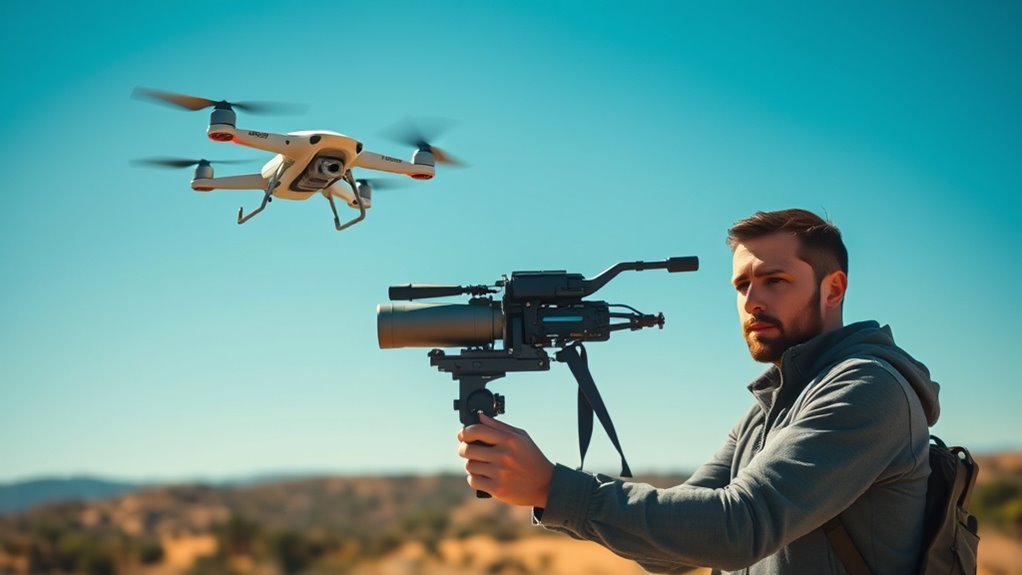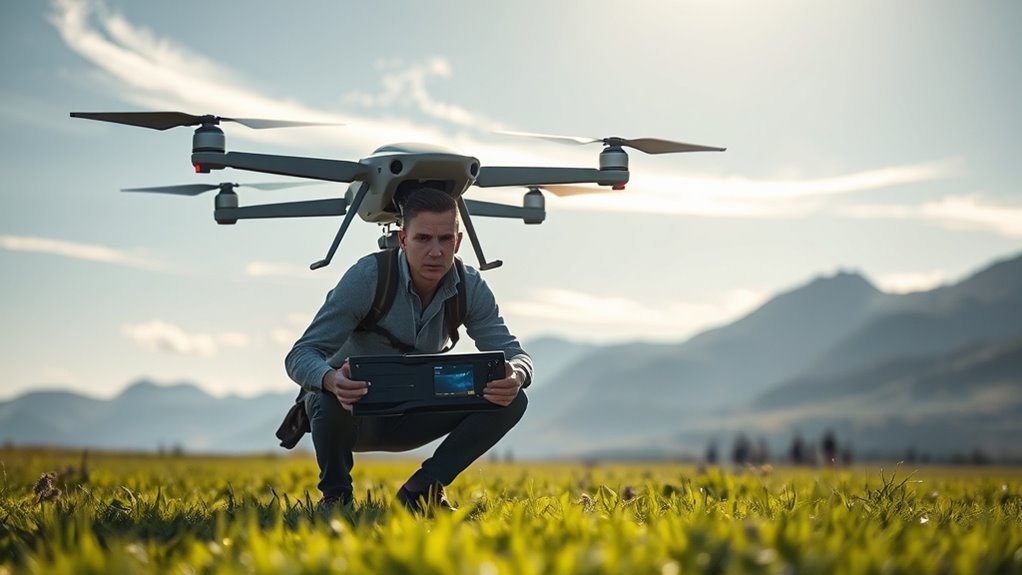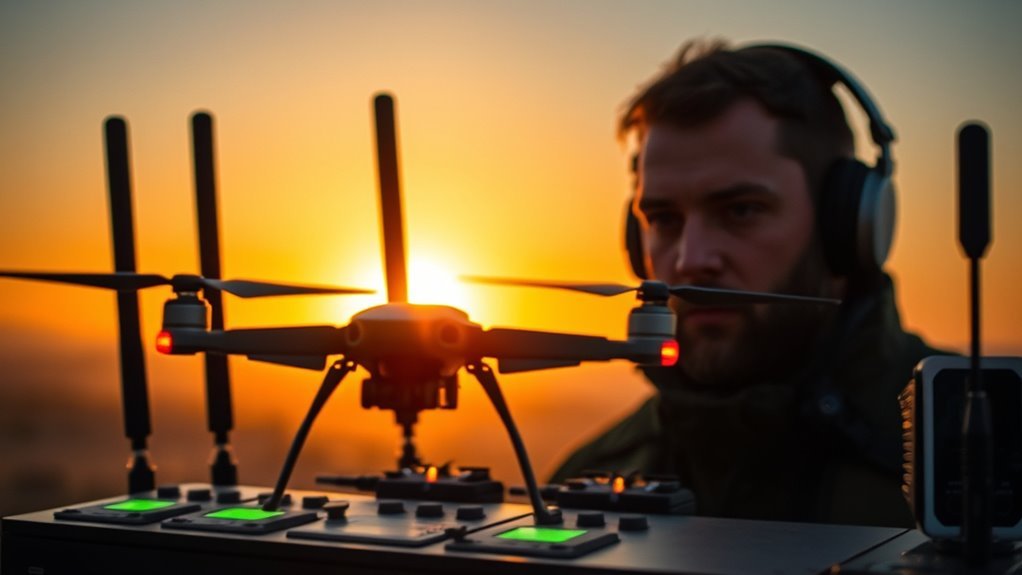To effectively take down drones, start by understanding the technology behind them and the legal implications of neutralization. Methods include jamming signals to disrupt communication, deploying nets for capture, or utilizing trained birds of prey. You can also create physical barriers like netting or no-fly zones. DIY distractions such as reflective surfaces or noise makers can confuse drones. Professional services offer advanced detection and removal techniques. Keep exploring to discover even more advanced strategies and solutions.
Understanding Drone Technology

As you explore understanding drone technology, it’s essential to recognize that these unmanned aerial vehicles (UAVs) are equipped with a variety of components that determine their functionality and applications. You’ll encounter several drone types, including fixed-wing, multirotor, and hybrid models, each serving distinct purposes. Key drone components include the flight controller, motors, batteries, sensors, and communication systems, all of which work in harmony to enable precise operation. Understanding these elements allows you to appreciate how drones navigate and perform tasks autonomously or semi-autonomously. This knowledge empowers you to engage with drone technology effectively, whether for recreational purposes or practical applications, enhancing your freedom to explore and innovate within this rapidly evolving field. Moreover, being aware of signal attenuation can improve your understanding of the limitations in drone performance, especially when operating in challenging environments. Additionally, many drones, such as the XG Neith, incorporate advanced camera capabilities that enhance the quality of visual content captured during flights.
Legal Considerations for Drone Neutralization

When considering drone neutralization, it’s essential to understand federal regulations that govern such actions. These laws can greatly influence your approach, while local statutes may impose additional restrictions or requirements. Failing to comply with these legal frameworks could result in severe penalties. Additionally, the legal consequences of shooting down a drone can lead to serious repercussions, including criminal charges and civil liabilities.
Federal Regulations Overview
While the desire to neutralize unauthorized drones can be strong, it’s crucial to understand the federal regulations governing such actions. The Federal Aviation Administration (FAA) enforces strict rules regarding drone interference due to safety and national security implications. Engaging in drone neutralization without proper authorization could result in severe legal repercussions.
| Regulation Type | Key Points |
|---|---|
| FAA Regulations | Prohibits unauthorized interference |
| Criminal Liability | Potential for fines or imprisonment |
| National Security Laws | Restrictions based on security concerns |
| Civil Liability | Possible lawsuits for damages incurred |
Before taking action, familiarize yourself with these federal drone regulations to protect your rights and maintain compliance.
Local Laws Impact
Understanding local laws is essential for anyone considering drone neutralization, since these regulations can greatly impact your actions and liabilities. Ignoring local ordinances can lead to severe consequences. Here are key considerations to keep in mind:
- Research local ordinances: Know what’s permissible in your area.
- Community awareness: Engage with neighbors about drone concerns.
- Potential penalties: Understand fines or legal actions for violations.
- Self-defense laws: Clarify how these apply to drone situations.
- Reporting procedures: Familiarize yourself with protocols for handling rogue drones.
Jamming Signals: How It Works

Jamming signals is one of the most effective methods for disabling drones in real-time. When you deploy jamming devices, they emit radio frequency signals that create signal interference, disrupting the communication between the drone and its operator. This interference can cause the drone to lose control, forcing it to land or return home. To effectively jam a drone, you need to understand its operating frequency and select a jamming device that matches or exceeds that range. However, it’s essential to be aware of legal implications, as unauthorized jamming can lead to significant penalties. By utilizing this method properly, you can safeguard your privacy and maintain autonomy against unwanted surveillance or intrusion from drones.
Drone Nets: A Tactical Approach
As drones become more prevalent in various settings, employing drone nets presents a tactical approach to effectively neutralize them. This method requires careful evaluation of net deployment strategies and efficient net recovery systems. Here are some key points to take into account:
- Targeting Accuracy: Confirm nets are deployed in line with the drone’s flight path.
- Range and Height: Adjust net launchers for ideal range and height based on drone type.
- Weight Capacity: Choose nets that can effectively capture drones without risking collateral damage.
- Immediate Recovery: Implement systems that allow quick retrieval of nets post-deployment. Responsible actions are crucial to minimize unintended harm during drone capture.
- Training: Equip your team with the necessary skills for effective net operation and recovery.
Incorporating proactive vulnerability identification can also enhance the overall effectiveness of drone defense strategies. Utilizing drone nets can safeguard your airspace while maintaining a tactical edge.
Electronic Countermeasures: Disruption Techniques
While the rise of drones poses unique challenges, employing electronic countermeasures can effectively disrupt their operations. You can utilize signal interference techniques to thwart a drone’s communication with its operator, rendering it unable to receive commands. By generating electronic noise or jamming frequencies, you can create a barrier that hampers the drone’s ability to function as intended. This approach falls under the umbrella of electronic warfare, where the aim is to disrupt adversaries’ capabilities without physical confrontation. Understanding the specific frequencies utilized by drones allows you to tailor your countermeasures effectively. Keep in mind that while these techniques can protect your privacy and autonomy, they must be employed within legal frameworks to avoid unintended consequences.
Using Birds of Prey for Drone Removal
Although many traditional methods exist for countering drones, using birds of prey has emerged as an innovative and eco-friendly solution. Harnessing the natural hunting instincts of these raptors can effectively neutralize drones while minimizing environmental impact. Here are some key considerations:
- Bird training: Properly trained birds, like falcons or hawks, can be adept at intercepting drones.
- Raptor behavior: Understanding their flight patterns is essential for effective drone engagement.
- Safety protocols: Ensuring the safety of both the bird and surrounding people is paramount.
- Legal regulations: Familiarize yourself with local laws regarding the use of raptors for drone removal.
- Training challenges: Developing a bird’s skills takes time and patience, requiring a dedicated approach.
Utilizing birds of prey offers a unique, freedom-friendly method for drone removal.
Physical Barriers: Creating Safe Zones
To effectively manage drone threats, implementing physical barriers like fencing and netting is essential. These structures can create designated no-fly zones, markedly reducing unauthorized drone access. You’ll find that establishing these safe zones not only protects sensitive areas but also enhances security protocols.
Fencing and Netting Solutions
Fencing and netting solutions serve as essential physical barriers that can effectively create safe zones against drone incursions. By utilizing various fencing materials and netting types, you can establish a robust defense system. Consider the following options:
- Chain-link fencing: Durable and versatile, it provides visibility while deterring unauthorized access.
- Electric fencing: Effective for keeping intruders away, adding a layer of deterrence.
- Bird netting: Lightweight and flexible, it can entrap smaller drones.
- High-tensile strength netting: Designed to withstand harsh conditions, this offers superior containment.
- Privacy fencing: Reduces visibility and can be combined with other measures for enhanced security.
Designated No-Fly Zones
Creating designated no-fly zones is a strategic approach to safeguarding specific areas from unauthorized drone activity. By implementing designated airspace management, you can establish clear boundaries that deter drone operators from infringing on sensitive locations. Effective no-fly zone enforcement involves utilizing technology, such as geofencing, to automatically restrict drone access in these areas.
Additionally, clear signage and public awareness campaigns help inform drone operators about prohibitions, fostering compliance. When establishing these zones, consider factors like proximity to critical infrastructure, wildlife habitats, and populated areas. By creating these safe zones, you not only protect privacy and security but also assert the importance of responsible drone use, ensuring freedom and safety coexist in the skies.
DIY Solutions: Creative Hacks to Distract Drones
How can you effectively distract an unwanted drone without resorting to expensive technology? You can employ several DIY distractions and creative decoys to divert its attention. Here are some practical hacks:
- Reflective Surfaces: Use mirrors or metallic sheets to confuse the drone’s sensors.
- Noise Makers: Create sounds with pots or bells to disrupt audio detection.
- Bright Lights: Shine powerful flashlights or laser pointers to disorient the drone.
- Smoke or Fog: Deploy smoke bombs to obscure visibility and confuse operators.
- Fake Targets: Set up decoys that mimic your presence, drawing the drone away.
Professional Drone Removal Services
While DIY distractions can be effective in certain situations, professional drone removal services offer a more robust solution for dealing with persistent or potentially harmful drones. These services utilize advanced drone detection systems to locate and neutralize threats efficiently. They also provide aerial surveillance services to monitor airspace and guarantee safety. Additionally, many of these services leverage AI-driven sensors to enhance their detection and response capabilities. Moreover, they often implement data security measures to ensure that sensitive information remains protected during operations.
| Service Type | Key Features | Benefits |
|---|---|---|
| Drone Detection | Real-time monitoring | Quick identification of threats |
| Removal Techniques | Jamming, net capture | Safe and controlled removal |
| Surveillance Services | Thorough airspace oversight | Enhanced situational awareness |
Future Trends in Drone Neutralization Techniques
As advancements in drone technology continue to evolve, so too must the methods for neutralizing them. Future trends in drone neutralization will likely focus on integrating autonomous systems and leveraging AI advancements. Here’s what you can expect:
As drone technology evolves, so must the strategies for neutralizing them, with a focus on autonomy and AI integration.
- AI-Driven Detection: Enhanced algorithms will enable quicker identification of unauthorized drones.
- Autonomous Countermeasures: Systems that can autonomously assess threats and respond without human intervention.
- Swarm Technology: Coordinated drones working together to neutralize threats effectively.
- Jamming Techniques: More sophisticated jamming systems that disrupt drone signals with precision.
- Electromagnetic Pulse (EMP) Devices: Innovations in EMP technology to disable drones without physical damage.
Frequently Asked Questions
What Are the Safety Risks of Taking Down Drones?
Imagine a scenario where you attempt to disable a drone, causing it to crash. This could lead to injuries, legal implications, and significant drone safety concerns, highlighting the risks involved in unauthorized drone interventions.
How Can I Report a Rogue Drone Incident?
To report a rogue drone incident, follow established drone reporting procedures. Document the incident thoroughly, including time, location, and any identifiable features, ensuring you provide precise details for effective resolution and potential regulatory action.
What Are the Costs Associated With Professional Drone Removal Services?
When considering drone removal costs, professional services typically range from a few hundred to several thousand dollars, depending on the complexity of the situation and equipment required. It’s crucial to evaluate your specific needs before engaging services.
Can I Legally Own Drone Neutralization Equipment?
Did you know that over 70% of drone incidents involve unauthorized flights? You can legally own neutralization devices, but you must comply with local drone laws, which vary considerably, so always check regulations before purchasing.
What Should I Do if a Drone Is Hovering Over My Property?
If a drone’s hovering over your property, document its presence and assess potential drone privacy violations. Be aware of legal implications; contacting local authorities might be necessary, but make certain you understand your rights regarding aerial surveillance.

